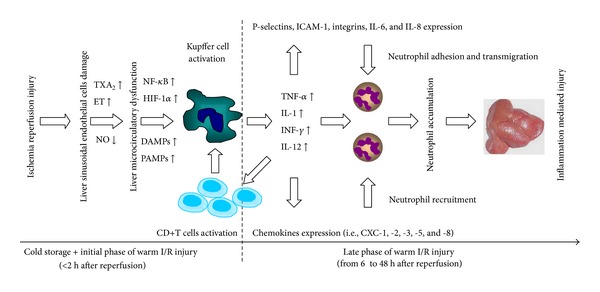Figure 1.

The inflammatory pathways of hepatic ischemia/reperfusion (I/R) injury. Liver sinusoidal endothelial cells (LSEC) damage, which occurs during cold preservation, represents the initial factor leading to liver I/R injury. Kupffer cell (KC) and LSEC edema, together with the imbalance between nitric oxide (NO) (↓) and thromboxane A2 (TXA2) (↑) and endothelin (ET) (↑), contributes to liver microcirculatory dysfunction. KC activation is promoted by damage-associated molecular patterns (DAMPs) (↑) and pathogen-associated molecular patterns (PAMPs) (↑) produced by neighbouring hepatic cells. Then activated KCs increase their release of ROS and proinflammatory cytokines including tumour necrosis factor-a (TNF-a), interleukin-1 (IL-1), interferon- (INF), interleukin-12 (IL-12), which induces the expression of P-selectin, intracellular adhesion molecule-1 (ICAM-1), integrins, IL-6, IL-8 in LSEC and the release of chemokines (i.e., CXC-1,-2,-3,-5, and -8). Additionally, IL-1 and TNF-a recruit and activate CD4+ T-lymphocytes, which amplify KC activation and promote neutrophil recruitment and adherence into the liver sinusoids and finally execute liver inflammation and injury.
